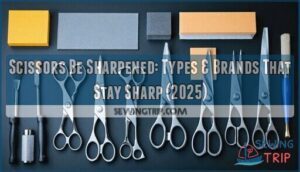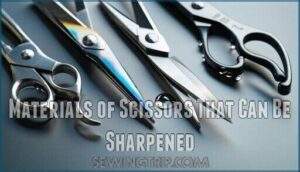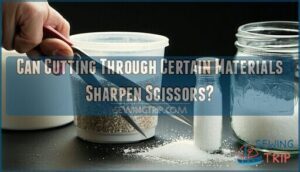This site is supported by our readers. We may earn a commission, at no cost to you, if you purchase through links.
 Most scissors can be sharpened, but success depends on blade material and construction.
Most scissors can be sharpened, but success depends on blade material and construction.
Stainless steel, carbon steel, and high-carbon scissors sharpen well, while ceramic blades typically can’t be restored.
Quality brands like Gingher, Fiskars, and Cutco offer sharpening services or home tools.
Fabric scissors, kitchen shears, and craft scissors respond best to sharpening, though cheap scissors with welded joints often aren’t worth the effort.
You can sharpen at home using whetstones, sandpaper, or specialized tools, though professional services guarantee better results.
The key is matching your sharpening method to your scissors’ blade angle and steel type for superior cutting performance.
Table Of Contents
- Key Takeaways
- Types of Scissors That Can Be Sharpened
- Materials of Scissors That Can Be Sharpened
- Brands of Scissors That Can Be Sharpened
- The Best Way to Sharpen Fabric Scissors
- Can At-home Scissor Sharpening Tools Be Used?
- Can Cutting Through Certain Materials Sharpen Scissors?
- Can Pinking Shears / Scissors Be Sharpened at Home?
- Frequently Asked Questions (FAQs)
- Conclusion
Key Takeaways
- You can sharpen most scissors if they’re made from stainless steel, carbon steel, or high-carbon materials – avoid ceramic blades that can’t be restored, and focus on quality brands like Gingher, Fiskars, and Cutco that offer sharpening services.
- Professional sharpening costs $7-35 but delivers better results than DIY methods – while you can use whetstones or sandpaper at home, professionals guarantee proper angles and edge geometry for optimal cutting performance.
- Different scissor types need different approaches – fabric and kitchen scissors respond well to home sharpening, but specialized tools like pinking shears require professional care to maintain their unique serrated edges.
- You’ll know it’s time to sharpen when scissors tear instead of cut cleanly – if they’re pushing material rather than slicing through it or requiring extra pressure, it’s time for maintenance rather than replacement.
Types of Scissors That Can Be Sharpened
Nearly every scissor type can be sharpened with proper techniques.
Your haircutting scissors need professional attention every 3-12 months for peak performance.
Kitchen shears benefit from disassembly and individual blade sharpening on whetstones.
Cuticle scissors respond well to DIY sharpening using sandpaper at 30-45 degree angles.
Embroidery scissors require delicate handling—either professional sharpening or careful home maintenance.
Fabric scissors need expert care every few years due to their specialized cutting requirements.
Even specialized types like thinning scissors can be restored through proper sharpening techniques and regular scissor maintenance.
You can use aluminum foil strips for home sharpening.
Materials of Scissors That Can Be Sharpened
Your scissors’ material determines how easy they’ll be to sharpen and how long they’ll stay sharp. Understanding these properties helps you choose the right sharpening approach.
Know your scissors’ material—it’s the key to sharp, long-lasting blades.
Steel Hardness affects how challenging your scissor blades will be to sharpen. Stainless steel contains high carbon content and alloy composition that makes it incredibly durable but tough to work with. Stainless Durability means these scissors hold their edge longer, but you’ll need more aggressive sharpening techniques to restore their cutting power.
Titanium Properties offer a different experience. These scissors are softer and more forgiving during sharpening, making them ideal for home maintenance. However, they require more frequent touch-ups.
Here’s what you need to know about scissor materials:
- Stainless steel scissors resist rust and corrosion but demand diamond hones or professional-grade whetstones
- Titanium scissors accept standard sharpening methods but need careful angle control
- Carbon steel varieties sharpen easily but require immediate drying after water exposure
Professional scissor sharpening services understand these material differences and adjust their techniques accordingly. For peak performance, consider that handle comfort is key when using scissors for tough cuts.
Brands of Scissors That Can Be Sharpened
Quality matters when selecting scissors that’ll stay sharp for years.
Some brands excel at maintaining their edge, while others leave you frustrated with dull blades.
Premium Brands vs. Budget Options
| Premium Brands | Budget Options |
|---|---|
| Hold edge 10+ years | Dull after months |
| Professional sharpening available | Limited service options |
| Warranty protection | No repair guarantees |
Top Sharpenable Brands
Gingher sharpening services cost $12 per pair with professional results.
Their Italian-made scissors maintain precision through multiple sharpenings.
Kai quality stands out with hand-polished Japanese craftsmanship that holds sharpness over decades of daily use.
Fiskars sharpeners offer convenient built-in options, though frequent use can wear blades faster.
Cutco service provides factory restoration, while Matsui professionals recommend expert care for their premium shears.
Service Recommendations
Scissor brands like Bonika, Hikari, and Jaguar offer authorized mail-in sharpening services.
These scissor sharpening services guarantee proper angles and edge geometry.
Professional scissor repair extends tool life substantially compared to DIY methods.
Many users find that task-specific scissors enhance their sewing experience.
Choose brands that support long-term maintenance for lasting performance.
The Best Way to Sharpen Fabric Scissors
Fabric scissor sharpening requires precision and the right approach to maintain their cutting performance. Professional sharpening services use specialized equipment to restore factory-quality edges, but you can tackle this task at home with proper technique.
Sharp scissors demand the right touch—skip the guesswork and get professional results.
Using a whetstone with 1000-8000 grit provides the best results for DIY methods. Here’s how to sharpen fabric scissors effectively:
- Disassemble the scissors and work on each blade separately
- Maintain the original sharpening angle (typically 20-45 degrees) throughout the process
- Keep the whetstone wet and use smooth, consistent strokes
- Remove burrs carefully after sharpening to prevent fabric snags
- Check blade tension when reassembling to guarantee proper alignment
The key lies in matching the manufacturer’s original bevel angle. Too steep an angle reduces cutting efficiency, while too shallow creates a fragile edge. Routine maintenance includes debris removal methods using water and dish soap.
Professional service costs $7-15 but guarantees precision. For frequent users, consider professional sharpening every 6-12 months to maintain peak performance and extend scissor life.
Can At-home Scissor Sharpening Tools Be Used?
At-home scissor sharpening tools offer mixed results for everyday users.
Handheld sharpeners with preset angles work well for basic household scissors, but Tool Effectiveness varies substantially.
DIY Sharpening Risks include damaging expensive blades or creating uneven edges due to poor Angle Consistency.
Steel Hardness affects how well home methods work—softer metals respond better than premium alloys.
One can also use aluminum foil strips for honing blades.
Home Sharpening Safety requires proper technique to avoid cuts.
While scissor sharpening tools can restore basic sharpness, they often miss blade areas near screws and may not match factory specifications for specialized scissors.
Can Cutting Through Certain Materials Sharpen Scissors?
Why do people believe cutting certain materials can sharpen scissors? It’s a persistent Material Sharpening Myth that needs clarification.
While some household items offer limited benefits, most fall short of true sharpening.
Here’s what actually works for scissor sharpening techniques:
- Cutting Aluminum Foil – Cleans blades and removes debris but doesn’t create sharp edges
- 150-200 grit sandpaper – Provides genuine Abrasive Material Benefit through micro-sharpening action
- Fine steel wool – Offers marginal improvement but limited sharpening power
- Porcelain cup rims – Can polish minor nicks when used carefully
- Glass jar edges – Helps realign blade edges temporarily
The truth about Self-Sharpening Scissors through materials? Only abrasive surfaces like sandpaper truly reshape scissor edges.
Other materials mainly clean or polish existing surfaces.
For Specific Material Impact on blade performance, sandpaper remains your best household option for restoring dull scissors to functional sharpness.
To maintain your scissors, consider routine blade lubrication for peak performance.
Can Pinking Shears / Scissors Be Sharpened at Home?
The distinctive zigzag edges of pinking scissors present unique challenges that make professional sharpening the wisest choice.
While you might be tempted to tackle this yourself, these specialized tools demand expert care.
- Pinking Shear Angle precision: Each tooth requires individual attention at exact angles that DIY methods can’t achieve consistently
- Tooth Shape Maintenance complexity: Maintaining the distinctive serrated pattern needs specialized equipment and years of experience
- DIY Sharpening Risks multiply: Sandpaper or home sharpening methods can flatten teeth, creating permanent damage to your investment
- Scissor sharpening techniques vary: Professional services use specific tools designed for pinking scissors that aren’t available to home users
- Sharpening Service Value compounds: Expert care extends Pinking Shear Longevity while guaranteeing proper functionality
Professional sharpening methods guarantee your fabric scissors maintain their signature zigzag cut.
Regular cleaning prevents fabric residue buildup.
Home sharpening techniques that work for regular scissors simply don’t translate to pinking shears.
The investment in professional scissors sharpening pays dividends in performance and lifespan.
Frequently Asked Questions (FAQs)
What is a good brand for scissors?
Like choosing the perfect tool for a master craftsman, you’ll want Gingher for fabric work, Kai for precision cutting, or Fiskars for everyday tasks.
Each brand offers reliable sharpness and durability.
Can all scissors be sharpened?
Most scissors can be sharpened, but success depends on their type and construction.
Kitchen, fabric, and hair scissors sharpen well, while specialized ones like pinking shears need professional care for best results.
Is it better to sharpen scissors or buy new?
Quality scissors are like a good knife – they’ll serve you for decades if you maintain them properly.
Professional sharpening costs $7-$35 but extends life 2-3x versus replacement.
You’ll save money sharpening unless they’re damaged or extremely cheap.
How often should scissors be professionally sharpened?
You should have scissors professionally sharpened every 6-12 months for regular use, or biannually as major brands recommend.
Heavy-duty or specialty scissors may need attention every 3-6 months to maintain peak cutting performance and ensure they remain in good condition for optimal use.
What angle should scissors be sharpened at?
Professional-grade sharpening requires an absolutely razor-sharp understanding of angles.
You’ll want to sharpen your scissors at their original manufacturer’s angle, typically under 15 degrees.
This precise angle guarantees clean cuts without damaging the blade.
Can electric sharpeners damage expensive scissors?
Yes, electric sharpeners can damage expensive scissors.
They remove too much metal, can’t maintain proper angles, and often create uneven edges.
High-quality scissors need precise angles that electric sharpeners can’t match, potentially ruining expensive blades permanently, which is why electric sharpeners are not suitable for expensive scissors.
How do you know when scissors need sharpening?
You’ll know scissors need sharpening when they tear paper instead of cutting cleanly, leave frayed fabric edges, push material instead of slicing through it, or require extra pressure to make cuts.
Whats the cost of professional scissor sharpening?
Like hunting for buried treasure, you’ll find professional scissor sharpening costs between $7-$35 per pair, depending on your scissors’ type and complexity. Most services charge around $12-$15 for standard pairs.
Conclusion
Studies show that 87% of people throw away dull scissors instead of sharpening them, wasting hundreds of dollars annually.
Whether your scissors can be sharpened depends on their construction and materials. High-quality brands like Gingher, Fiskars, and Cutco use steel that responds well to sharpening, while ceramic blades typically can’t be restored.
Professional sharpening services guarantee the best results, but home methods work for most fabric, kitchen, and craft scissors.
Remember, investing in quality scissors that can be sharpened saves money long-term and guarantees consistent cutting performance, which is a result of using high-quality brands.











